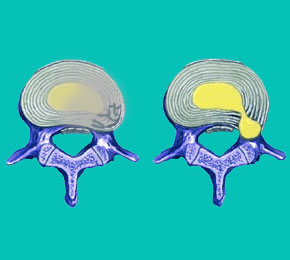
Degenerative disc disease causes herniated discs. This is a simple fact of human anatomy. However, intervertebral herniations which are caused by DDD are rarely symptom-generating. This is because the nucleus of degenerated discs has shrunk in size and decreased in its ability to pressure neurological tissue upon bulge or rupture.
Degenerative disc disease is a normal aspect of life and usually begins to show itself in the human spine around the age of 30. Some patients might demonstrate it quite a bit younger and a few might not demonstrate major intervertebral desiccation for another decade or so. However, as long as the person remains alive, degenerative disc disease will eventually show itself and begin to change the spinal anatomy in definite and predictable ways.
This dissertation provides proof that disc degeneration does indeed cause intervertebral herniation. However, just because a disc herniates does not mean that symptoms will occur. In fact, research and clinical evidence definitively tells that the vast majority of herniated discs are not symptomatic, nor will they become so to any significant degree.
How Degenerative Disc Disease Causes Herniated Discs
Degenerative disc disease acts on both the outer disc wall, called the annulus fibrosus, as well as the interior disc nucleus, called the nucleus pulposus:
The annulus becomes dry and brittle. Its multi-layered design often cracks and suffers structural breakdown that weakens the disc wall. Eventually, the outer wall succumbs to pressure from within the disc enacted by the nucleus, as well as to stress caused by movement and impact within the spine from external sources. The annulus might bulge asymmetrically or herniate, allowing a pocket of nucleus tissue to form, or rupture, ranging from a small annular tear to a complete and spontaneous explosive migration of nucleus material from the disc. The worse the annulus degenerates, the more likely it is to herniate or rupture with a whimper, rather than with any real force. This is because while the annulus is deteriorating, the nucleus is also undergoing changes.
DDD affects the nucleus by desiccating the moisture-rich core contained within. The nucleus shrinks in mass and potential to pressure the outer disc wall. Its shock-absorbing ability decreases and its height is reduced, which is why older people tend to get shorter during the years of substantial spinal deterioration.
Disc Disease Causes Herniated Disc Consequences
We have already discussed the fact that most herniated discs, regardless of cause, are completely or virtually completely asymptomatic. We have also reported that among herniated discs that are symptomatic, the expressions are usually acute and transient presentations, rather then chronic problems. Herniated discs caused by degenerative disc disease are no exceptions to these rules, and if anything, support them in totality.
Herniated discs can only create symptoms when they influence nerve tissue, such as a compressing or chemically irritating a nerve root or the spinal cord. Degenerated bulging discs are less likely to herniate into the spinal cord or against a spinal nerve, since their mass has been decreased and the pressure they exert during a bulge or herniation is therefore lessened.
Degenerated discs are more likely to suffer annular tears and migration of nucleus material when compared to younger, healthier discs. However, the decreased mass of the nucleus and its desiccated state make it far less likely that an intervertebral rupture will enact chemical radiculitis, when compared to a younger, healthier disc. Therefore, all the evidence points to degenerative-induced herniations as being the least likely to generate symptoms.
Degenerative Disc Disease Causes Herniated Discs Evidence
Degenerative disc disease is the laughable medical name given to the completely normal process of intervertebral desiccation, which simply means the drying out of the disc structure. DDD is not truly degenerative, since it does not get worse and worse and it certainly is not a disease.
Many doctors have called degenerative disc disease the greatest scapegoat in the orthopedic medical community and we agree 100% with this opinion. After all, we know that DDD will occur in 100% of people as age progresses. We know that the condition is self-limiting. We also know that it normally occurs at locations of tremendous intervertebral movement, such as between C4 and C7 and between L4 and S1. Not at all coincidentally, these are also the locations where herniated discs also occur with most frequency.
In summary, we know that DDD is not completely innocent, since it does directly lead to intervertebral herniation. In rare cases, herniated discs can become real problems and sources of severe pain. However, since most herniations are not symptomatic and since those created through the normal process of degeneration have the least potential to become symptomatic, we are not concerned with the truth that degenerative disc disease causes herniated discs.
Herniated Disc > Causes of a Herniated Disc > Degenerative Disc Disease Causes Herniated Discs





